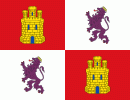Castile and León (Castilla y León)
 |
 |
It was created in 1983, eight years after the end of the Francoist regime, by the merging of the provinces of the historic region of León: León, Zamora and Salamanca with those of Castilla La Vieja (Old Castile): Ávila, Burgos, Palencia, Segovia, Soria and Valladolid. The provinces of Santander and Logroño, which until then had formed part of Castile, opted out of this merger and formed the new Autonomous Communities of Cantabria and La Rioja respectively.
Castile and León is the largest autonomous community in Spain in terms of area, covering 94,222 km2. It is however sparsely populated, with a population density below 30/km2. While a capital has not been explicitly declared, the seats of the executive and legislative powers are set in Valladolid by law and for all purposes that city (also the most populated municipality) serves as de facto regional capital.
Castile and León is a landlocked region, bordered by Portugal as well as by the Spanish autonomous communities of Galicia, Asturias, Cantabria, the Basque Country, La Rioja, Aragon, Castilla–La Mancha, the Community of Madrid and Extremadura. Chiefly comprising the northern half of the Inner Plateau, it is surrounded by mountain barriers (the Cantabrian Mountains to the North, the Sistema Central to the South and the Sistema Ibérico to the East) and it is drained by the Douro River, flowing west toward the Atlantic Ocean.
The region contains eleven World Heritage Sites, making it (along with Lombardia in Italy) the region with most UNESCO World Heritage Sites. UNESCO recognizes the Cortes of León of 1188 as the cradle of worldwide parliamentarism.
The Statute of Autonomy of Castile and León, reformed for the last time in 2007, establishes in the sixth article of its preliminary title the symbols of the community's exclusive identity. These are: the coat of arms, the flag, the banner and the anthem. Its legal protection is the same as that corresponding to the symbols of the State -whose outrages are classified as crime in article 543 of the Penal Code-.
In the articulated statuary, the coat of arms is defined as follows: "The coat of arms of Castile and León is a stamped shield by open royal crown, barracked in cross. The first and fourth quartering: in the field of gules, a merloned golden castle of three merlons, drafted of sable and rinse of azure. The second and third quartering: in a silver field, a rampant lion of purple, lingued, dyed and armed with gules, crowned with gold."
Likewise, the flag is described as follows: "The flag of Castile and León is quartered and contains the symbols of Castile and León, as described in the previous section. The flag will fly in all the centres and official acts of the Community, to the right of the Spanish flag."
Following the same wording, the banner is constituted by the shield quartered on a traditional crimson background. The Statute also expresses: "The anthem and the other symbols [...] will be regulated by specific law". After the promulgation of the fundamental norm, this law was not promulgated, so the anthem does not exist, but de iure is a symbol of autonomy.
Map - Castile and León (Castilla y León)
Map
Country - Spain
 |
 |
| Flag of Spain | |
Anatomically modern humans first arrived in the Iberian Peninsula around 42,000 years ago. The ancient Iberian and Celtic tribes, along with other pre-Roman peoples, dwelled the territory maintaining contacts with foreign Mediterranean cultures. The Roman conquest and colonization of the peninsula (Hispania) ensued, bringing the Romanization of the population. Receding of Western Roman imperial authority ushered in the migration of different non-Roman peoples from Central and Northern Europe with the Visigoths as the dominant power in the peninsula by the fifth century. In the early eighth century, most of the peninsula was conquered by the Umayyad Caliphate, and during early Islamic rule, Al-Andalus became a dominant peninsular power centered in Córdoba. Several Christian kingdoms emerged in Northern Iberia, chief among them León, Castile, Aragon, Portugal, and Navarre made an intermittent southward military expansion, known as Reconquista, repelling the Islamic rule in Iberia, which culminated with the Christian seizure of the Emirate of Granada in 1492. Jews and Muslims were forced to choose between conversion to Catholicism or expulsion, and eventually the converts were expelled through different royal decrees.
Currency / Language
| ISO | Currency | Symbol | Significant figures |
|---|---|---|---|
| EUR | Euro | € | 2 |
| ISO | Language |
|---|---|
| EU | Basque language |
| CA | Catalan language |
| GL | Galician language |
| OC | Occitan language |
| ES | Spanish language |
























